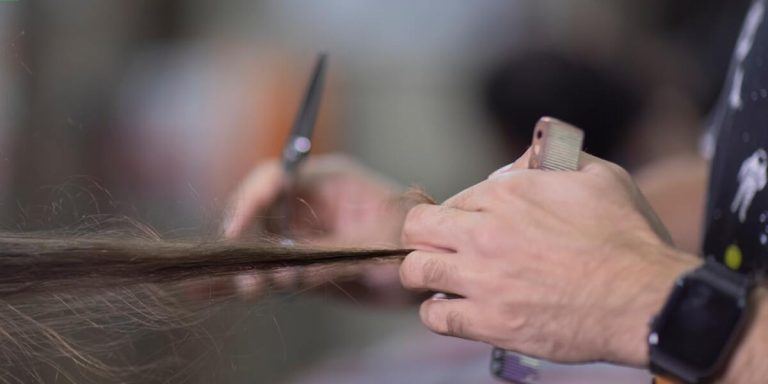Damaged Hair Care Routine: Your Guide to Revitalizing Tresses
Living with brittle, split-ended tresses can be incredibly frustrating. If you’re searching for a reliable damaged hair care routine, look no further. Recurrent heat styling or exposure to harsh environmental factors often cause these seemingly irrevocable issues by stripping natural oils from your locks.
This guide provides an effective roadmap for restoring health and luster to lifeless hair. By consistently putting in the proper hair maintenance efforts and timely intervening with the right products and tools, you can certainly revitalize your mane! Let’s delve deeper into how to nurse your hair back to its original vitality.
Did you know?
Did you know that wet hair can stretch up to 30% of its original length? However, overstretching it while damp can lead to significant damage and breakage.
Understanding the Basics of a Damaged Hair Care Routine
Damaged hair often stems from neglect, harsh chemicals, and unsuitable products. Knowing the basics of a damaged hair care routine can significantly enhance your hair’s health and appearance. In 2023, incorporate these steps into your daily routine for the best results:
- Use gentle, nourishing shampoos.
- Deep condition once a week.
- Protect your hair from heat styling.
- Trim regularly to prevent split ends.
- Stay hydrated and eat a balanced diet for healthy hair growth.
First, identify and prevent what damages your hair. Common culprits are:
- Overusing heat styling tools like curling irons or straighteners without protection
- Chemical treatments like coloring or perms
- Insufficient hydration, leading to dryness and brittleness
Curbing these factors is essential for healthier hair.
Identifying Signs of Hair Damage
Damaged hair is a common problem that both men and women encounter due to several factors like environmental pollutants, harsh chemical treatments, excessive heat styling or poor diet. Knowing how to spot the signs of damage can be your first step in creating an effective damaged hair care routine.
Firstly, you should know what healthy hair looks like – it’s shiny, soft and easy to manage with minimal breakage or frizz. If any changes occur from this condition such as dryness, brittleness or dull appearance – consider these as clear indicators of damage.
When running fingers through the strands feels rough indicating raised cuticles instead of smooth ones on undamaged hairs – it’s time for action. Split ends are another sure sign where individual fibers split into two at tips showing need for hydration and nourishment.
Compromised health often manifests as regular tangles, and an elasticity test offers scientific proof. To perform the test:
- Take a strand of hair between your fingers.
- Stretch it slightly.
If the hair breaks instantly without reverting back, it likely indicates severe damage. In this case, you should immediately adopt a proper damaged hair care routine.
Increased shedding than usual could also highlight deeper issues involved often overlooked by many people. Simple brushing shouldn’t result in clumps coming out nor washing causing too much fall similar pointing towards weakened roots needing reinforcement pronto!
Key Elements in a Daily Damage-Repair Regimen
Damaged hair can often seem like a never-ending concern. However, integrating the right elements into your daily damaged hair care routine can lead to noticeable improvements in texture and shine.
Firstly, gently cleanse your hair. Wash with sulfate-free shampoos designed for damaged hair to avoid stripping away natural oils with harsh products or excessive heat. These gentler formulas clean without removing necessary moisture from your strands.
Second is deep conditioning – an absolute must when it comes to caring for distressed locks! A good quality conditioner replenishes critical hydrating nutrients improving elasticity while reducing tendency towards breakage over time.
Incorporate weekly intensive treatments, like nourishing masks or hot oil remedies, into your regimen to infuse higher concentrations of reparative ingredients deeper within each strand for faster restoration results than regular conditioners alone.
To style your hair effectively, limit heated tool use that can break down the protein structure in the follicle, causing:
- Dullness
- Split ends
- Various other damage-related problems
Heated tools have gained popularity and varying usage patterns exist among different age groups. These groups often join online communities to discuss these issues and seek advice on better management strategies. Moving forward, our collective aim is to promote healthier long-term hair growth by ensuring a continuous cycle of renewal. This remains critical despite unique external factors impacting each individual’s well-being positively.
Essential Products for Nourishing Damaged Hair
Damaged hair often looks dull and feels dry. Common causes include regular heat styling, over-processing, and exposure to harsh environmental elements like strong sun rays. To rejuvenate your locks and solve these problems, establish an effective care routine that focuses on deeply nourishing products.
Use a high-quality moisturizing shampoo designed for damaged hair as your first line of defense against distressed tresses. Look for formulas that:
- Contain potent ingredients to repair structural damage in each strand
- Gently cleanse the scalp without causing further harm
- Deliver necessary nutrients deep into the core structure of your strands
Incorporate a rich conditioner for damaged hair into your cleansing regimen to heal your hair. A good conditioner:
- Fills in irregularities caused by breakage or split ends.
- Smooths the surface layer of your hair.
- Makes it easier to manage frizz-prone locks.
- Improves overall hair appearance.
Take time once a week (or more if needed) for intensive conditioning treatments. Use masks that:
- Are packed with replenishing elements.
- Provide hydration.
- Bolster resilience from root to tip.
Include these essential items in your daily battle against worn-out follicles.
Restorative Shampoo and Conditioner Selections
Choosing a restorative shampoo and conditioner is the first step to an effective damaged hair care routine. With a myriad of products available in 2023, it’s essential to know how each caters towards the recovery process.
A good starting point are shampoos fortified with proteins such as keratin or collagen. They work by filling gaps in your hair shaft that result from damage while also providing strength for future protection.
Also worth investigating are sulfate-free options. Sulfates can strip away natural oils along with dirt, leaving your locks dry and brittle hence exacerbating any pre-existing condition.
Conditioner-wise, look out for those packed with moisturizing ingredients like shea butter or argan oil. These help combat dryness by replenishing lost moisture hence restoring elasticity which in turn prevents breakage.
For extreme cases of damage consider deep conditioning treatments once every week alongside regular use of leave-in conditoner for additional boost during days you don’t wash your mane.
As part of this regimen remember heat styling tools should ideally be set on low since high temperatures may further stress already compromised strands causing them more harm than good.
Finally make sure UV-protection sprays become part pf your must-haves if you’re bound to spend time outdoors under the sun – these act as shields against ultraviolet rays’ damaging effects on our tresses.
In conclusion practicing patience plays key role when nursing back health into harmed manes because results aren’t instant but definitely rewarding!
Deep Conditioning Treatments and Masks
Choosing the right deep conditioning treatments and masks can significantly improve your damaged hair care routine. These products are essential to heal, restore moisture, and replenish nutrients lost due to damage.
Deep conditioners work wonders on severely damaged hair. They penetrate deeper into the hair shaft than regular conditioners. Regularly indulging in a good-quality deep conditioner will not only repair existing damage but also protect against future harm.
Hair masks indulge your tresses with intense nourishment. Maximum potency formulations often consist of natural oils like argan oil, shea butter, or coconut oil that show significant positive effects on dry and damaged locks when used regularly as part of a comprehensive home-care routine.
In 2023, you can easily improve your hair health from the comfort of your home with excellent options such as:
- Shea Moisture Raw Shea Butter Deep Treatment Mask, packed with restorative ingredients
- Olaplex No 5 Bond Maintenance Conditioner, known for mending broken bonds within each strand
- Kérastase Resistance Masque Therapiste Hair Mask, perfect for those facing beyond normal levels of breakage
Supplementing these super hydrating treatments with other exercises such as minimising heat styling tools use and getting regular trims can boost their effectiveness exponentially!
Advanced Techniques to Revitalize Damaged Locks
There’s no denying that frequent exposure to harsh chemicals, heat and environmental pollutants can cause significant damage to your hair. But fret not! This 2023, there are advanced techniques you can incorporate into your damaged hair care routine to breathe life back into those tired tresses.
Embrace the power of protein treatments to transform damaged locks. Protein treatments strengthen hair from within and are vital for a modern-day repair regimen. Seal in moisture by using leave-in conditioners or natural oils such as argan and jojoba after washing your hair.
Lastly, and perhaps most importantly, use heating tools cautiously because they often cause severe breakage and split ends. Whenever possible, choose to air dry your hair or use products with heat protection properties if you must use heat styling tools.
Remember – recovery won’t happen overnight but patience coupled with consistent application of these cutting-edge approaches will undoubtedly lead toward stronger, healthier strands before long!
Incorporating Protective Styling Practices
Incorporating protective styling into your damaged hair care routine is a pro-active step towards healthier, stronger locks. It’s more than just an emerging trend in 2023; it has proven efficacious in minimalizing further damage and aiding the process of revitalization.
Consider these essential practices for Protective Styling to assist you on your revival journey:
1. Opt for Loose Hairstyles: Tight hairstyles like high ponytails or braids can strain follicles leading to breakage over time. Switch them out with looser styles reducing tension on roots minimizing any pulling effect.
2. Embrace Low Manipulation Styles: Consider adopting low manipulation styles such as twists or buns which require less handling thus decreasing chances of causing physical damages.
3. Use Satin Head Wraps and Pillowcases: Cotton pillowcases have a tendency to tug at your hair while sleeping, exacerbate frizz, and absorb moisture from scalp causing dryness thereby contributing to damage overtime.
Contrarily satin materials offer smooth surfaces allowing strands move freely without friction preventing tangles/breakages.
4.Try Hands off Approach: The easiest way to protect your tresses is by simply letting them be! Touching/pulling/handling excessively causes unnecessary stress/friction leading eventually down path maintaining healthy locks becoming much harder task then initially anticipated.
Harnessing Heat-Free Drying Methods
Harnessing heat-free drying methods is a pivotal part of any damaged hair care routine. Damaged hair craves gentleness and the associated relief from intense stress or pressure, including excessive styling with heated tools.
Embrace towel-drying as your new best friend in this journey to revitalized locks. But beware—rubbing wet strands can lead to unwanted frizz and breakage, two foes you definitely don’t want on your list if healthier-looking tresses are what you aim for. Instead of roughly toweling off water post-shower, try the following methods:
- Pat down gently with a towel.
- Use an old soft T-shirt or a microfiber cloth to minimize friction while still absorbing excess moisture effectively.
Next stop – air drying! It might sound simple, but you can make it work wonders for your mane with a few steps. After a gentle towel dry:
- Detangle using a wide-tooth comb, which is less damaging than traditional brushing that often harshly pulls at knots.
- Apply leave-in conditioner to damp hair, evenly distributing it through the length while avoiding the roots to prevent them from being weighed down and looking flat.
Then practice patience! Let the wind, nature’s natural fan, work its magic. Avoid touching those beautiful silkies too much to prevent transferring oils from your hands that could disrupt the process and cause delays. Minimizing contact also reduces the risk of creating unwanted flyaways.
Conclusion
Your damaged hair care routine should be simple and consistent, using the right products. Revive dull locks with just a few steps:
- Cleanse with gentle shampoos or co-washes.
- Use deep conditioning treatments regularly.
- Apply oils for nourishment.
- Seal moisture in with leave-in conditioners.
Remember, rejuvenating your tresses takes time, so patience is key. For more knowledge on maintaining healthy hair and innovative suggestions for “Hair Care and Maintenance,” explore our website. It brims with useful tips!







